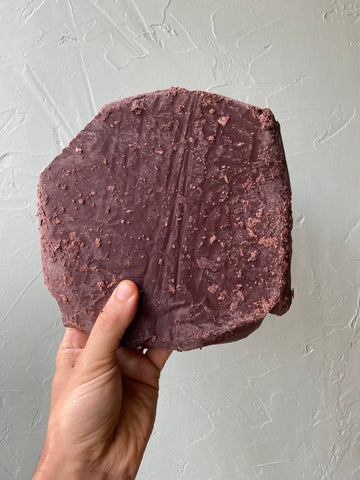Why does my chocolate turn white?
We've all been there - you pick up one of your favourite chocolate bars (mouth salivating), tear open the wrapper (stomach grumbling) in excitement to enjoy that perfectly tempered, shiny chocolate. Instead, you are presented with a white, dull, and quite honestly weird looking lump of chocolate.
What happened? Well, there are a few different scenarios that we're likely to play out. Let me discuss each and how to spot one from another.
Cause #1:
Heat destroyed your shiny chocolate
This has to be one of the most common issues of chocolate going white. If chocolate is exposed to high heat environments, it will melt. It is the cocoa butter in the recipe that is responsible for melting. Cocoa butter is a type of fat, and one that will begin to melt above 32°C, or approximately 90°F.
After the chocolate has cooled and re solidified, white streaks or blotches may take over the surface of the chocolate. This is known as fat bloom - where the cocoa butter has separated from the solids. Look on the bright side, sometimes the patterns that emerge from fat bloom are beautiful. Check out some bloom below.

Chocolate that is untempered and displays signs of fat bloom

Chocolate that is untempered and displays signs of fat bloom

Chocolate that is untempered and displays signs of fat bloom
Cause #2:
Sudden humidity changes messed with your chocolate
Chocolate has many friends (hands up if you're a chocolate lover) and thankfully, very few enemies. Humidity is one of those enemies. As chocolate makers, we are often asked about chocolate storage and we advise against hiding your stash in the fridge. Here's why:
Have you ever taken something out of the fridge, only to find condensation forming on the inside of the bag, or on the product itself? Well, chocolate is hydrophobic, meaning it doesn't mix well with water. So if you introduce moisture to your chocolate you are likely to experience what is called sugar bloom.
Sugar bloom forms when moisture develops on the outside of your chocolate. Sugar dissolves and recrystallizes forming a white, grainy texture once the moisture has evaporated.
Cause #3:
The manufacturer did not temper your chocolate well (far less likely)
For those of you who do not know what tempering is, it is a process where chocolate is heated and cooled to specific temperatures, allowing a crystal formation to develop and take hold in the cocoa butter specifically (known as form IV). This formation gives the finished product the shine and snap we so desire with chocolate. Properly tempered chocolate also has a higher melting point so its all not about vanity, okay? You've most likely heard the phrase 'Melt in your mouth, not in your hands'. Well, you can thank tempering for that.
Tempering is tricky and can cause major headaches and backlogs in chocolate production if it does not go to plan. If tempering does not go so well, it's evident to us chocolate makers when we visually inspect the bars before packaging. Are there any noticeable streaks on the chocolate? Is my chocolate releasing from the moulds properly? You see, tempered chocolate contracts differently than untempered, so it will release easily from the moulds it was deposited into. If the chocolate is stuck, it's a sign the process didn't go as planned.
Thank goodness chocolate makers can re melt their chocolate and try again if tempering goes poorly. Just imagine all of the waste if you couldn't! Or, maybe you'd just notice novice chocolate makers packing on the pounds from having to eat their mistakes. All kidding aside, there are times where lack of experience is to blame for poorly tempered chocolate heading out to be sold when it shouldn't.
Let's finish with some good news
The weird, white, possibly grainy, untempered chocolate is still edible and delicious - it's just presented in a different way. If you were feeling really inspired, you could melt it all down and re temper the chocolate, building up those form IV crystal structures us chocolate makers love so much. Or, you could just snack away and enjoy the fun and funky textures that are being presented to you!

Chocolate bar being held up and inspected for proper temper techniques
Cheers to great tasting, and aesthetically pleasing chocolate!


